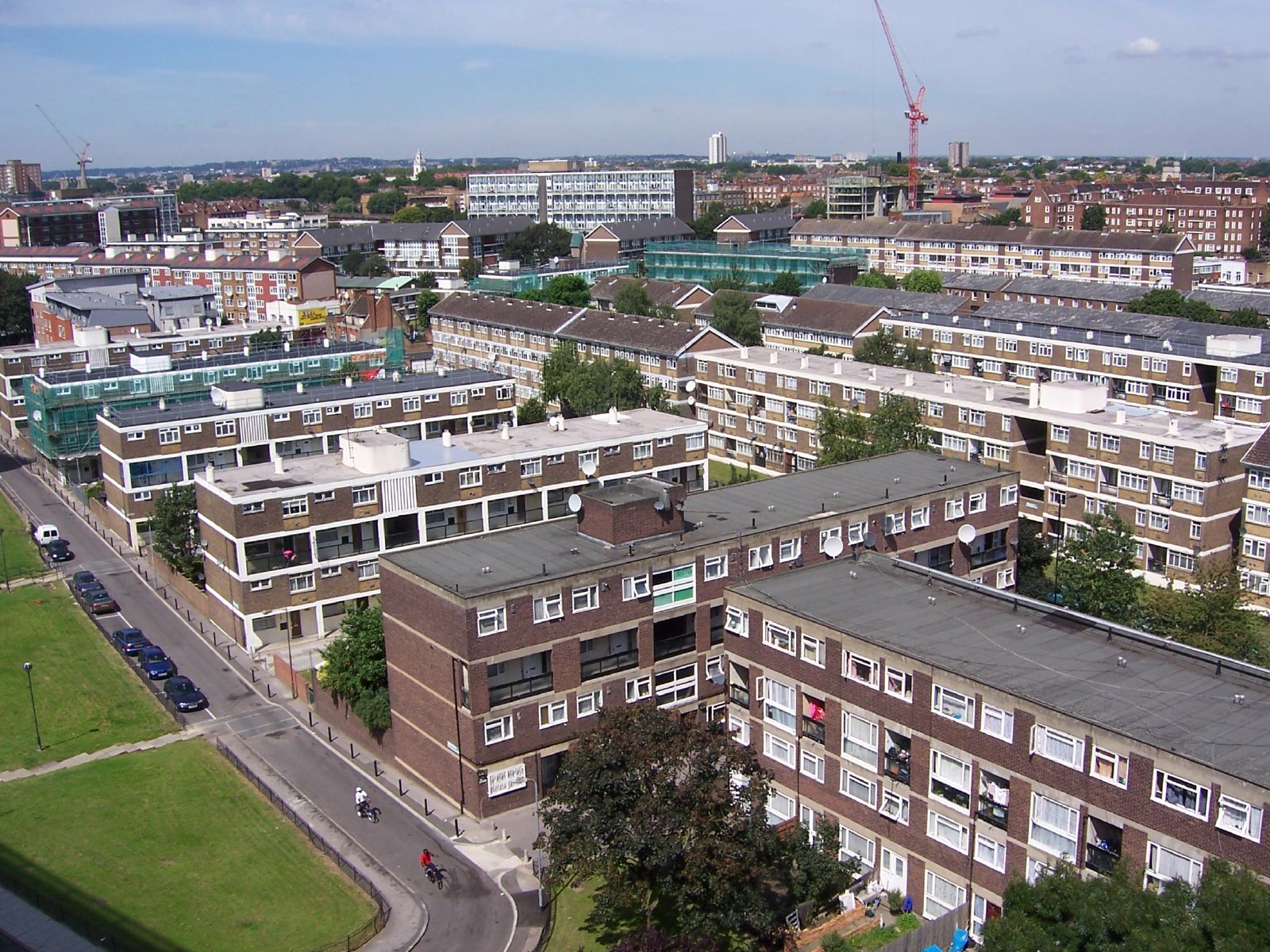In the United Kingdom, social rented housing provides residents with secure tenancies and reduced rents tied to local incomes. Much of the UK’s social rented housing stock was built by local authorities in the 1960s and 70s as council estates. Now, following long-term disinvestment and having become associated with a variety of social issues, many of these estates, particularly in London, are being eyed up for ‘regeneration’ schemes. The stated aims of these schemes are usually to address physical deterioration, crime, and deprivation, while also delivering new homes and managing severe budget cuts. In London, around 120 estates are either set to undergo regeneration or are already being regenerated (Estate Watch, n.d.). If approved schemes are implemented, these projects will lead to a net loss of 13,500 social rented homes since 2003 (Berry, 2021). While the nature of regeneration schemes varies and resident ballots have been introduced, the dispersal of existing tenant communities and the reduction of social rented units has nonetheless led some to label estate regeneration as a form of state-led gentrification and as a continuation of political efforts to undermine social housing (Lees et al., 2016; Watt, 2021).
The contested nature of estate regeneration raises the question of where its legitimacy arises from. How is it that these schemes, particularly comprehensive ones, with the associated disruption to residents and the carbon-intensiveness of demolition, have succeeded in being implemented on such a large scale? Many researchers would point to a process of stigmatisation that has led to a dominant imaginary of ‘sink’ estates as dens of crime, deprivation, and social immobility. Channel 4’s 2005 ident filmed in the Aylesbury Estate is a well-known example of this—the short clip exaggerated the bleakness of the estate to align it with popular caricatures, contributing to a sink estate reputation that was then capitalised upon by those trying to deliver its regeneration (Lees, 2013). The concept of ‘territorial stigmatisation’ has been developed by Loïc Wacquant, amongst others, to make sense of how ‘noxious representations of space’ that are ‘produced, diffused, and harnessed in the field of power’ impact marginalised populations and justify the growing reach of capital (Wacquant et al., 2014, p. 1273). Much of this work investigates the ties between political economy, class power, and symbolic processes in an age of intensifying marginalisation, as well as their combined impact on urban space (see, for example, Slater, 2015 or Larsen, 2014). This well developed body of literature provided a useful starting point as I began to develop ideas for my own research in my master’s dissertation.
As I looked over this work, what appeared to be absent was an in-depth examination of the role of what I term ‘design discourse’ in generating legitimacy for estate regeneration. Many of these estates, built in the 1960s and 70s, were designed according to modernist architectural principles intended to supply rationally laid-out housing with adequate space, facilities, air, and daylight. Almost every document arguing for estate regeneration problematises these ‘outdated’ modernist design practices in relation to current urban design orthodoxy and presents the correction of their designs as a key rationale for regeneration. My dissertation examines how this discourse manifests in the case of the Gascoigne Estate regeneration in Barking, and unpacks its origins, political content, and influence on the regeneration process. It asks: What are the key distinctions constructed by designers between modernist and current design practices as they try to establish legitimacy for estate regeneration? And how are these distinctions established through design discourse?
One of the key themes that has arisen from this research into this design discourse is the framing of social issues as spatial problems—requiring spatial solutions. For example, current Secure by Design (SBD) guidance treats crime as something to be designed away and is based on Defensible Space theory principles originating in the 1970s. Through this lens, crime on the estate, rather than being seen as a product of deprivation and marginalisation, is a consequence of a built environment that is difficult to police or surveille. Defensible Space theory is not without political content. It rose to orthodoxy in the United Kingdom due to its ‘hegemonic compatibility’ with the ideological position of the Thatcher government, insofar as it reframed the welfare state ‘from being a remedy for social problems to part of their cause’ and provided techniques to manage the social fallout of neoliberal restructuring (Jacobs and Lees, 2013, p. 1577; p. 1576; Knoblauch, 2015). Another example of this spatial lens was the stated desire of planners and designers to create a ‘mixed community’ that would supposedly facilitate social mobility. However, in reality, mixed community policies often centre on the distribution of populations and therefore promote the deconcentration of deprived residents while encouraging an inflow of a higher income population, in service of the regeneration of the wider town centre (Lees, 2008; Raco, 2007). In this sense the spatialised framing diverts ‘attention from the causes of inequality that are rooted within the wider welfare system’ while helping to justify gentrificationary urban renaissance goals (Arbaci and Rae, 2013, p. 475).
Interviews and documents also emphasise a distinction between the modernist design approach of the estate and the traditionalist typologies that influenced the regeneration masterplan. Again, an unspoken political ideology informs this distinction, which becomes clear when examining the alignment between this distinction and the ideas popularised by the think tank Create Streets, which directly influenced the creation of the Government’s £150m Estate Regeneration fund in 2014, and is closely affiliated with the right wing think tank Policy Exchange (Slater, 2015). It appears that this essentialist emphasis on the distinction between modernism and traditional design is formulated to justify the redevelopment of modernist social housing in order to construct traditionally-styled dwellings aimed at a more affluent population. The emphasis on tradition also closely aligns with a parallel emphasis on connecting the site to the town centre. The language used in the discussion of connectivity positions the estate outside of the town centre and ascribes social exclusion to the physical form of the estate, rather than, for example, the ‘combined weight of material deprivation and external stigmatisation’ (Watt, 2021, p. 22).
Design discourse therefore manifests as a set of distinctions: while the existing estate is discussed as generating crime and as being problematically mono-tenurial, the new scheme designs it out and creates a mixed community. The existing estate is considered as following outdated design principles, while the new scheme follows supposedly timeless, traditional ones. Consequently, the existing estate is considered as producing social disorder, while regeneration promises to bring a more affluent and compliant population. In locating social problems in a built form, the case to restructure that built form is powerfully made. When we identify the political content of these distinctions it becomes possible to challenge them and advocate more strongly for proposals centred on social and environmental sustainability.
References
Arbaci, S. and Rae, I. (2013) ‘Mixed-Tenure Neighbourhoods in London: Policy Myth or Effective Device to Alleviate Deprivation?’, International Journal of Urban and Regional Research, 37(2), pp. 451-479.
Berry, S. (2021) Estate redevelopment in London: Have things improved under the current Mayor? Available at: https://www.london.gov.uk/sites/default/files/2021_01_estate_redevelopment_in_london_data_sian_berry_am.pdf (Accessed: 27 July 2022).
Estate Watch (n.d.) Estates Under Threat. Available at: https://www.estatewatch.london/pages/estates/underthreat/ (Accessed: 6 February 2023).
Jacobs, J.M. & Lees, L. (2013) ‘Defensible Space on the Move: Revisiting the Urban Geography of Alice Coleman’, International Journal of Urban and Regional Research, 37(5), pp. 1559-1583.
Knoblauch, J. (2015) ‘The Economy of Fear: Oscar Newman Launches Crime Prevention through Urban Design (1969–197x)’, Architectural Theory Review, 19(3), pp. 336-354. DOI: 10.1080/13264826.2014.1036492.
Larsen, T.S. (2014) ‘Copenhagen’s West End a ‘Paradise Lost’: the political production of territorial stigmatization in Denmark’, Environment and Planning A, 46, pp. 1386-1402. DOI: 10.1068/a45640.
Lees, L. (2008) ‘Gentrification and Social Mixing: Towards an Inclusive Urban Renaissance?’, Urban Studies, 45(12), pp. 2449-2470). DOI: 10.1177/0042098008097099.
Lees, L. (2013) ‘The Urban Injustices of New Labour’s “New Urban Renewal”: The Case of the Aylesbury Estate in London’, Antipode, 46(4), pp. 921-947
Lees, L., Shin, H.B. & Lopez-Morales, E. (2016) Planetary Gentrification. Cambridge: Polity
Raco, M. (2007) ‘Securing Sustainable Communities: Citizenship, Safety and Sustainability in the New Urban Planning’, European Urban and Regional Studies, 14(4), pp. 305-320. DOI: 10.1177/0969776407081164.




Interesting the political force promising incredible progress, under achieving and advertising success with no mention of the forced displacement of the poor en mass.
The design definitely improves the environment but at what real cost.
Tough balancing act to achieve.